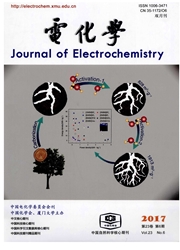

 中文摘要:
中文摘要:
在Ti基体上,采用电沉积法制备了镨(Pr)和聚乙烯毗咯烷酮(PVP)掺杂的Ti/SnO2-Sb20CPhO3-PVP-PbO2电极.SEM测试显示,Ti/SnO2-Sb20CPhO3-PVP-PbO2电极表面颗粒细化,镀层结构更加致密和均匀.XRD分析说明掺杂可以使电极的表面颗粒变小.循环伏安(CV)测试表明,共掺杂改性后的电极电催化活性明显提高.强化寿命测试显示Ti/SnO2-Sb20CPhO3-PVP-PbO2电极稳定性更好,使用寿命更长.将所制备的电极应用于甲基蓝(MB)模拟染料废水的降解测试,与常规的Ti/Pb02电极相比,Ti/SnO2-Sb20CPhO3-PVP-PbO2电极对甲基蓝具有更好的脱色率和COD除去率.降解120min后,对30mg·L-1甲基蓝的去除率可达99%,对COD去除率为87.9%.
 英文摘要:
英文摘要:
The titanium (Ti) based lead oxide (PbO2) electrodes doped with praseodymium oxide (Pr2O3) and polyvinylpyrrolidone (PVP) were prepared by electrodeposition. The surface morphologies and structures of the as-prepared thin films were characterized by scanning electron microscopy (SEM) and X-ray diffraction (XRD) technique, respectively. The results showed that the denser and more uniform coatings with smaller particles and larger surfaces were obtained by doping, which modified the micro-structure of the Ti/SnO2-Sb2O3/Pr2O3-PVP-PbO2 electrode. Cyclic voltammetry (CV) was also used to study the electrocatalytic activity of electrodes and higher oxidation capacity was obtained with the Ti/SnO2-Sb2O3/Pr2O3-PVP-PbO2 electrode. The accelerated life of Ti/SnO2-Sb2O3/Pr2O3-PVP-PbO2 electrode was considerably longer than that of undoped anode. Compared with conventional Ti/PbO2 electrodes, the Ti/SnO2-Sb2O3/Pr2O3-PVP-PbO2 electrodes exhibited higher decolorization rate and removal rate of COD, reaching 99% and 87.9%, respectively, after the electrolysis time of 120 min during the process of degrading simulative dyeing waste water of methylene blue. The good electrocatalytic performance of Ti/SnO2-Sb2O3/Pr2O3-PVP-PbO2 makes it a promising anode for treatment of organic pollutants in aqueous solutions.
 同期刊论文项目
同期刊论文项目
 同项目期刊论文
同项目期刊论文
 Fabrication and Characteristics of a Nanostructure PbO2 Anode and its Application for Degradation of
Fabrication and Characteristics of a Nanostructure PbO2 Anode and its Application for Degradation of Effect of Electrochemical Modification Method on Structures and Properties of Praseodymium Doped Lea
Effect of Electrochemical Modification Method on Structures and Properties of Praseodymium Doped Lea Fabrication of La-doped TiO2 Film Electrode and investigation of its electrocatalytic activity for f
Fabrication of La-doped TiO2 Film Electrode and investigation of its electrocatalytic activity for f 期刊信息
期刊信息
